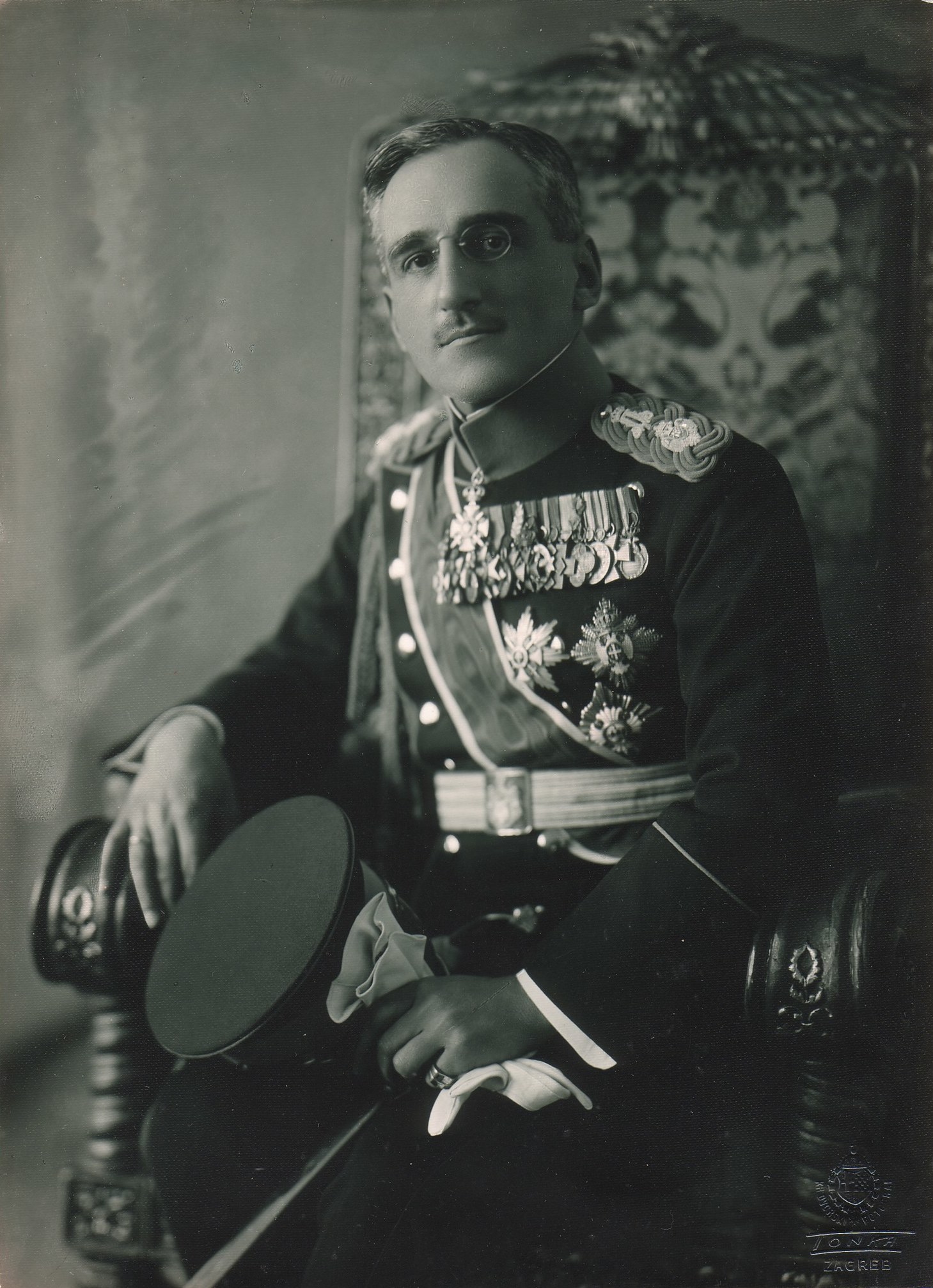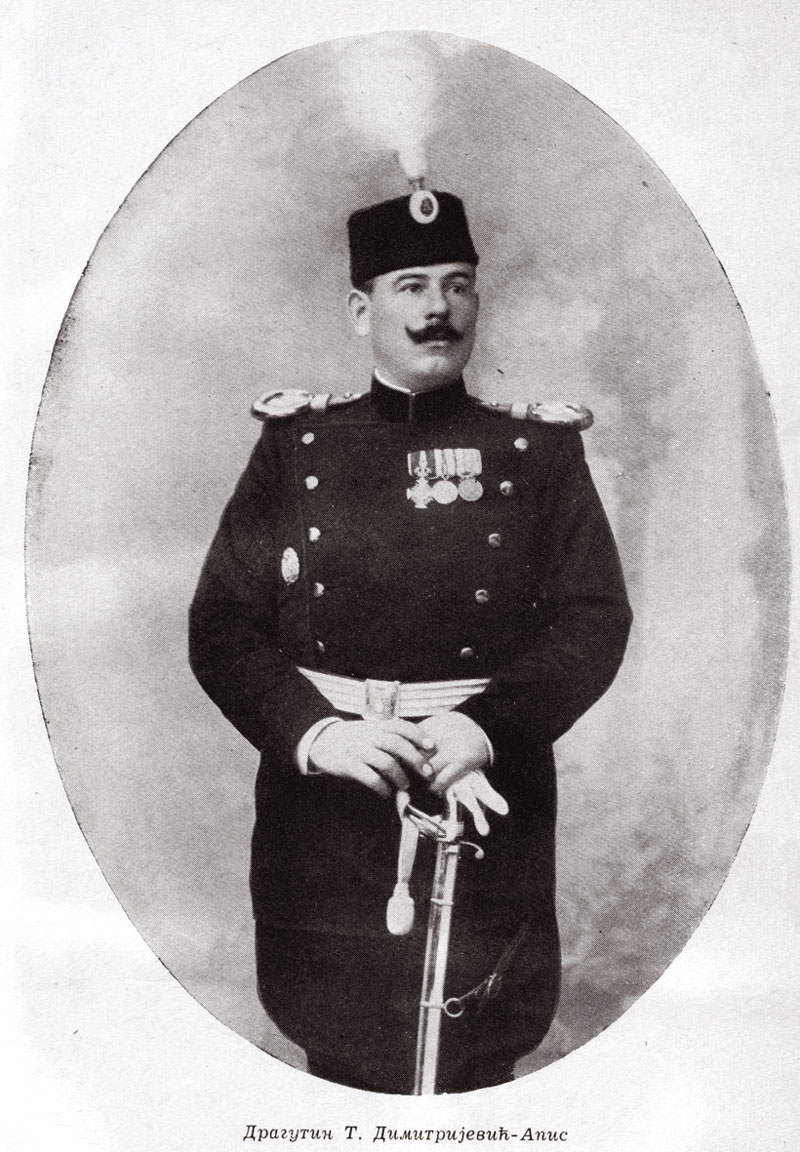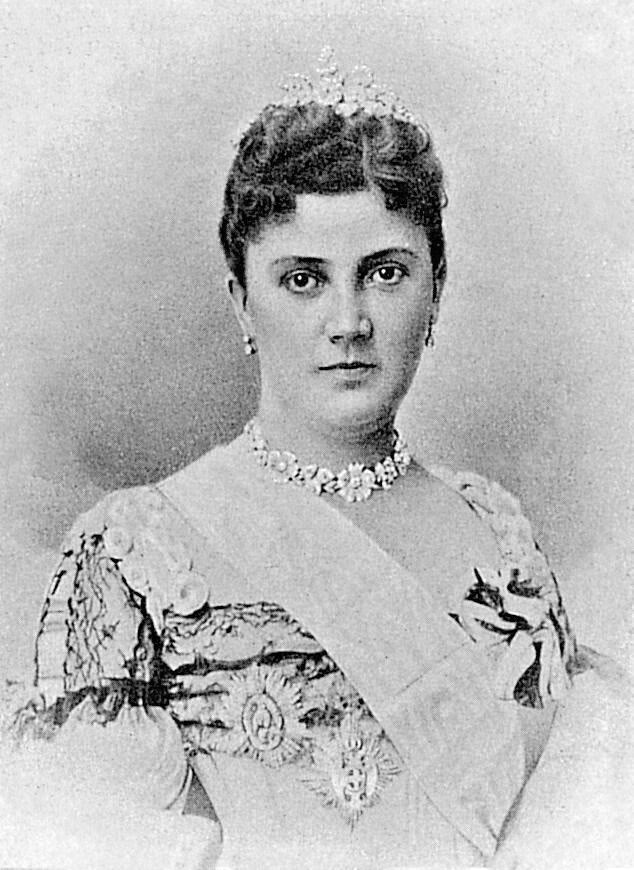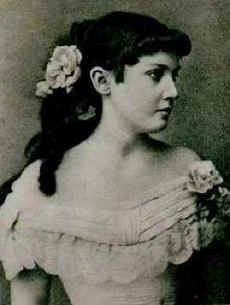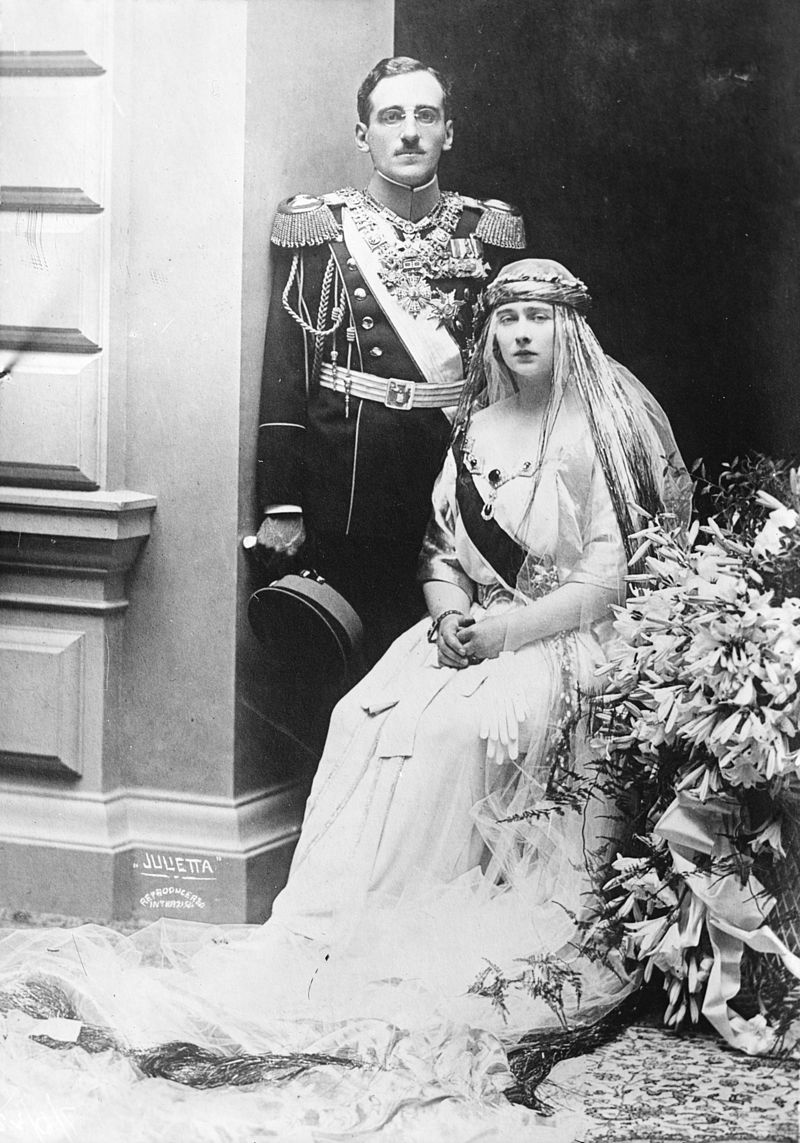by Susan Flantzer
© Unofficial Royalty 2022

St. George’s Church; Credit – By Jelko – Own work, CC BY-SA 3.0, https://commons.wikimedia.org/w/index.php?curid=21400020
St. George’s Church is a Serbian Orthodox church located at the top of the Oplenac Hill in the town of Topola, Serbia. It is the burial site of the Serbian/Yugoslavian Royal Family from the House of Karađorđević. The church is part of Oplenac, a complex that also includes The King’s Winery and Vineyard, the Vineyard’s Keeper’s House, King Peter’s House, and Karađorđe’s Residence.
- Unofficial Royalty: Kingdoms of Serbia/Serbs, Croats, and Slovenes/Yugoslavia Index
- Unofficial Royalty: Serbian/Yugoslavian Royal Burial Sites
*********************
History of St. George’s Church

King Peter I of Serbia, founder of St. George’s Church which is in the background); Credit- https://oplenac.rs/
St. George’s Church was built to replace an earlier church in Topola that had been built by Đorđe (George) Petrovic, called Karađorđe (Black George) (1768 – 1817), the founder of the House of Karađorđević, to be the burial site of his new dynasty. Unfortunately, in 1813, Topola was attacked by the Ottoman Turks and the church was severely damaged. Even more unfortunate, on July 26, 1817, Karađorđe was killed by supporters of Miloš Obrenović, from the rival House of Obrenović. This act started decades of feuding between the House of Karađorđević and the House of Obrenović.
Karađorđe’s son Alexander Karađorđević, (sovereign) Prince of Serbia did some restoration in the town of Topola and had planned to build a new church but in 1858, Alexander was forced to abdicate by the rival House of Obrenović which held power until 1903. In 1903, a coup d’etat led by army officers who supported the House of Karađorđević assassinated King Alexander I of Serbia and his wife Queen Draga, resulting in the extinction of the rival House of Obrenović. Prince Peter Karađorđević, the son of Alexander Karađorđević, was then proclaimed King Peter I of Serbia (King of the Serbs, Croats, and Slovenes from 1918 to 1921).

St. George’s Church in the distance, atop Oplenac Hill with the town of Topola in the foreground; Credit – By XJeanLuc at English Wikipedia, CC BY-SA 3.0, https://commons.wikimedia.org/w/index.php?curid=5982584
Peter I immediately set out to plan a new church. In 1903, he chose the site for the church atop the 1105-foot/337-meter-high Oplenac Hill. The initial architect and his plans were scrapped due to Peter I’s intense dislike of the plans. Another set of preliminary architectural plans was submitted by prospective architects to a committee and the commission was awarded to the young Serbian architect Kosta Jovanović. Peter I and the committee were impressed with Jovanović’s expertise in Serbian medieval architecture and his inventive design for the church. On May 1, 1910, construction on the new church began. The church was mostly complete by the fall of 1912. On September 23, 1912, Dimitrije Pavlović, Metropolitan of Belgrade dedicated the church in honor of Saint George (also known as George of Lydda), the same Saint George who is the patron saint of England.

The incomplete St. George’s Church in 1915; Credit – By K.u.k. Kriegspressequartier, Lichtbildstelle – Wien – https://www.bildarchivaustria.at/Preview/15454244.jpgCatalog: https://www.bildarchivaustria.at/Pages/ImageDetail.aspx?p_iBildID=15454244, Public Domain, https://commons.wikimedia.org/w/index.php?curid=54265966
The 1912 – 1913 Balkan Wars and World War I caused pauses in the completion of the church. When Serbia was occupied by Austrian-Hungarian troops in 1915, the church was looted and damaged. After World War I, restoration on the damaged parts of the church occurred along with work on the incomplete parts but Peter I did not live long enough to see the church completed. He died on August 16, 1921, and his son and successor Alexander I, King of the Serbs, Croats, and Slovenes (1921 – 1929), King of Yugoslavia (1929 – 1934) took over its completion.
The church was consecrated again on September 9, 1930, by Varnava Rosić, Patriarch of the Serbian Orthodox Church. During World War II, Yugoslavia (the country became known as the Kingdom of Yugoslavia in 1929) was occupied by Germany, and Peter II, King of Yugoslavia went into exile. In 1944, Communist Party leader Josip Broz, later known as Tito, established a Communist government. In November 1945, the monarchy was formally abolished and King Peter II was officially deposed. Yugoslavia would remain a Communist country for over forty years. Services continued in the church until 1947. Under the Communist government, St. George’s Church was declared a cultural monument and was converted into a museum of the Karađorđević dynasty. In 1991, after the fall of the Communist regime, members of the Serbian/Yugoslav royal family were able to return to their family homeland. On October 8, 1991, St. George’s Church was consecrated again and formally restored as a Serbian Orthodox church.
*********************
The Exterior of St. George’s Church

St. George’s Church; By Malecko86 – Own work, CC BY-SA 3.0, https://commons.wikimedia.org/w/index.php?curid=35755492
Serbian architect Kosta Jovanović designed St. George’s Church in a unique Serbian-Byzantine style with a Neo-Byzantine cross-shaped base and a huge central dome surrounded by four smaller domes at the points of the cross. The church was constructed using white marble from the Venčac Mountain near Arandjelovac, Serbia.

The mosaic of St. George above the entrance; Credit – By Julian Nyča – Own work, CC BY-SA 4.0, https://commons.wikimedia.org/w/index.php?curid=15371896
Above the main entrance is a semi-circle mosaic of the church’s patron St. George with the face of Karađorđe, the founder of the House of Karađorđević, slaying the dragon, symbolizing the victory of the Serbs over their enemies. The mosaic was designed by Serbian artist Paja Jovanović and was made in Venice, Italy.

The sculpted old coat of arms of the House of Karađorđević; Credit – https://oplenac.rs/st-georges-church/#gallery243-1
Above the mosaic in a circle, is a sculpted old coat of arms of the House of Karađorđević
*********************
The Interior of St. George’s Church
Orthodox churches are set up differently than other Christian churches. They are divided into three main parts: the narthex, the nave, and the sanctuary. The narthex is the passage hall between the outer door and the interior parts of the church. It is the symbolic connection between the church and the outside world. It used to be the practice that non-Orthodox people had to remain in the narthex but this practice has mostly fallen into disuse. The congregation stands in the nave, the main part of the church during services. Traditionally there is no sitting during Orthodox services and so Orthodox churches usually do not have pews or chairs.

The Iconostasis; Credit – By Ванилица – Own work, CC BY-SA 4.0, https://commons.wikimedia.org/w/index.php?curid=78926944
In Orthodox Christianity, an iconostasis is a wall of icons and religious paintings that divides the sanctuary from the nave. The sanctuary is where the Divine Liturgy is performed behind the iconostasis, accessible only to the clergy. The iconostasis usually has three doors, one in the middle and one on either side. The middle door is traditionally called the Beautiful Gate and is only used by the clergy.

Examples of mosaics in St. George’s Church; Credit – By Alekino – Own work, CC BY-SA 3.0, https://commons.wikimedia.org/w/index.php?curid=16377213
The interior is covered with 725 mosaic images made in Italy (513 in the church, 212 in the crypt). The mosaics are reproductions of medieval frescoes in Serbia. Copies of frescoes from sixty Serbian medieval churches and monasteries were brought to St. George’s Church for reference.

Mosaic of King Peter I, St. George, Mary the Mother of God, and Jesus; Credit – https://oplenac.rs/st-georges-church/#gallery243-19
On the entire southern wall of the narthex is a mosaic of the founder King Peter I, wearing his regalia and holding a model of St. George’s Church in his left hand. St. George is holding his right hand and guiding him to Mary, Mother of God and Jesus.
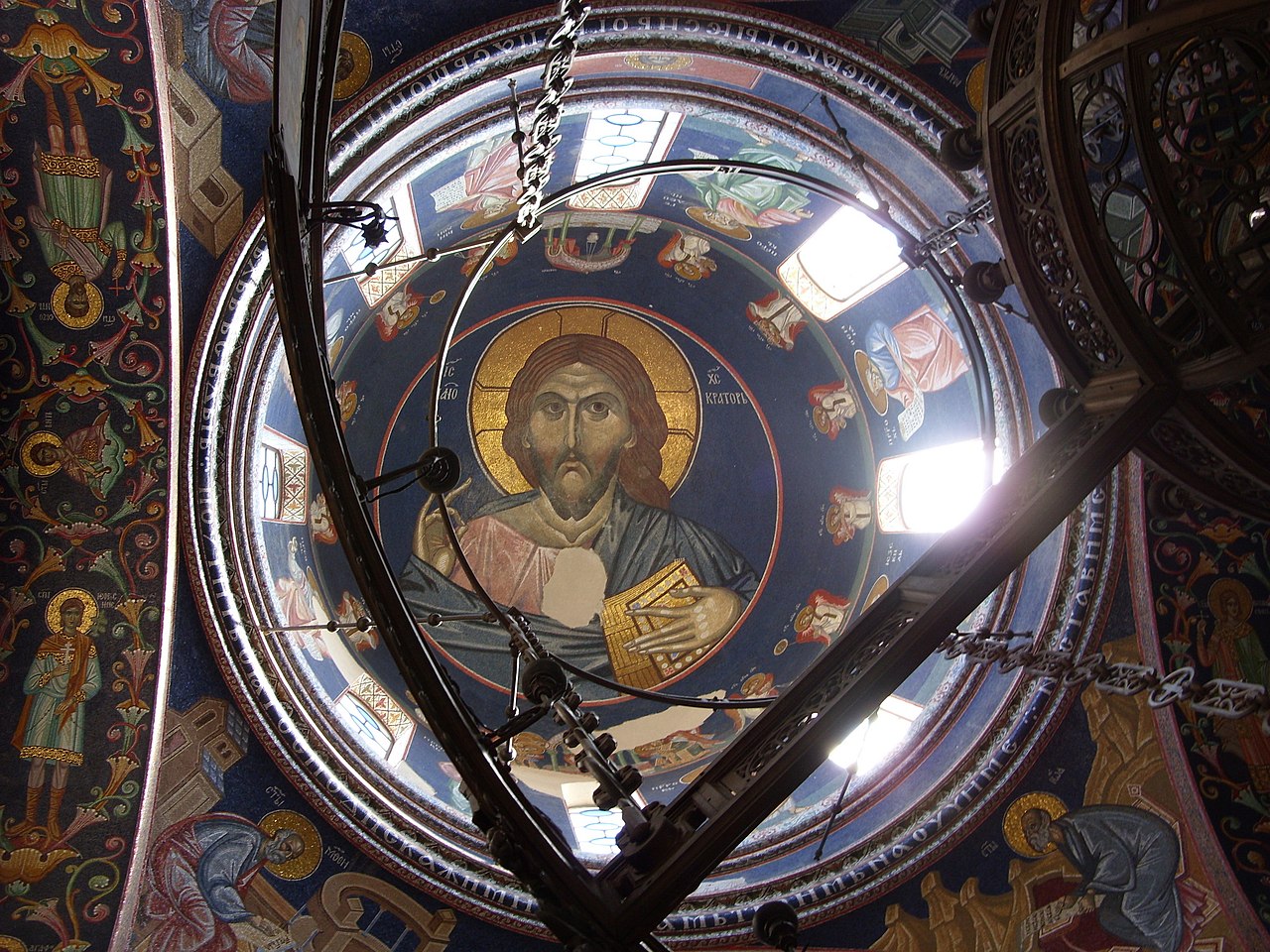
The main dome at St. George’s Church; Credit – Credit – By Julian Nyča – Own work, CC BY-SA 4.0, https://commons.wikimedia.org/w/index.php?curid=15371774
The interior of the main dome is a mosaic of Christ Pantokrator (Pantokrator = Almighty or All-Powerful). Christ Pantokrator is mostly an Eastern Orthodox concept that depicts Christ as a mild but stern, all-powerful judge of humanity. The mosaic on the main dome of St. George’s Church is a copy of the fresco (below) on the dome of the 1321 Gračanica Monastery in Gračanica, now in Kosovo.

The original fresco on the dome of the 1321 Gračanica Monastery; Credit – https://www.world-archaeology.com/travel/ulpiana-the-romans-in-kosovo/
*********************
May 26, 2013 – State Funeral and Reburial of King Peter II, Queen Alexandra, Queen Maria, and Prince Andrej
King Peter II, his wife Queen Alexandra (born Princess Alexandra of Greece and Denmark), his mother Queen Maria (born Princess Maria of Romania), and his brother Prince Andrej finally came home to Serbia and were laid to rest in a state funeral at St. George’s Church on May 26, 2013. The funeral service and burial was attended by members of the Serbian royal family, Serbian government officials, ambassadors, and members of other royal families.
King Peter II died on November 3, 1970, in Denver, Colorado, following a failed liver transplant. Per his wishes, he was interred at the Saint Sava Monastery Church in Libertyville, Illinois. Queen Alexandra died on January 30, 1993, in Burgess Hill, England. She was initially buried in the Royal Burial Grounds at Tatoi Palace in Greece near her parents King Alexander of Greece and Aspasia Manos. Queen Maria died in London, England on June 22, 1961. A great-granddaughter of Queen Victoria, she was buried at the Royal Burial Ground at Frogmore in Windsor, England. Prince Andrej died in Irvine, California on May 7, 1990, and was first buried at New Gračanica Monastery, a Serbian Orthodox monastery in Third Lake, Illinois.
- Oplenac: Extraordinary State Funeral 26 May 2013
- Serbia state funeral for King Peter II – BBC News – YouTube
Burials at St. George’s Church

The tombs of Đorđe Petrovic, called Karađorđe (Black George), founder of the House of Karađorđević, and his grandson Peter I, King of Serbia, the founder of St. George’s Church, across from each other; Credit – By Ванилица – Own work, CC BY-SA 4.0, https://commons.wikimedia.org/w/index.php?curid=78923275
There are two burials in the transepts of St. George’s Church. A transept is an area crosswise to the nave in a cross-shaped church so that the nave and the transepts form a cross. Deserving of their special burial places in the transepts are Đorđe Petrovic, called Karađorđe (Black George), founder of the House of Karađorđević, and his grandson Peter I, King of Serbia, the founder of St. George’s Church.
- Đorđe (George) Petrovic, called Karađorđe (Black George) (1768 – 1817), founder of the House of Karađorđević
- Peter I, King of Serbia from 1903 to 1918, King of the Serbs, Croats, and Slovenes from 1918 to 1921 (1844 – 1921), son of Alexander Karađorđević, (reigning) Prince of Serbia

The crypt under St. George’s Church; Credit – By Ванилица – Own work, CC BY-SA 4.0, https://commons.wikimedia.org/w/index.php?curid=78926927
There are 40 tombs in the crypt beneath the church, and as of the publication of this article, 28 members of the House of Karadjordjevic have been buried in the crypt, representing six generations of the family. The tombs were used without special order and without respecting criteria, such as generations, kinship, and order of death.
The remains of a number of members of the House of Karađorđević were transferred to St. George’s Church from their original burial sites. If known, information about the transfers is listed below.
In the crypt under the church:
- Marica Živković (died 1811), mother of Đorđe (George) Petrovic, called Karađorđe (Black George)
- Prince Alexius of Serbia (1836 – 1840), son of Alexander Karađorđević, (reigning) Prince of Serbia
- Jelena Jovanović (circa 1765 – 1842), wife of Đorđe (George) Petrovic, called Karađorđe (Black George), founder of the House of Karađorđević
- Prince Svetozar of Serbia (1841 – 1847), son of Alexander Karađorđević, (reigning) Prince of Serbia
- Princess Jelisaveta of Serbia (1851 – 1852), daughter of Alexander Karađorđević, (reigning) Prince of Serbia
- Princess Kleopatra of Yugoslavia (1835 – 1855), daughter of Alexander Karađorđević, (reigning) Prince of Serbia
- Prince Andrej of Serbia (1848 – 1864), son of Alexander Karađorđević, (reigning) Prince of Serbia
- Princess Jelena of Yugoslavia (1846 – 1867), daughter of Alexander Karađorđević, (reigning) Prince of Serbia
- Persida Nenadović, Princess of Serbia (1813 – 1873), wife of Alexander Karađorđević, (reigning) Prince of Serbia, first buried in Vienna, Austria, remains were transferred in 1912 to St. George’s Church
- Alexander Karađorđević, reigning Prince of Serbia (1806 – 1885), first buried in Vienna, Austria, remains transferred in 1912 to St. George’s Church
- Princess Milena of Serbia (1886 – 1887), daughter of Peter I
- Prince Djordje of Serbia (1856 – 1889), son of Alexander Karađorđević, (reigning) Prince of Serbia
- Zorka of Montenegro, Princess Karađorđević (1864 – 1890), wife of Peter I, first buried at the Cetinje Monastery in Cetinje, Montenegro, remains were transferred in 1912 to St. George’s Church
- Prince Andrej of Serbia (born and died 1890), son of Peter I, died at birth along with his mother Zorka
- Alexander I, King of the Serbs, Croats, and Slovenes from 1921 to 1929, King of Yugoslavia from 1929 to 1934 (1888 – 1934), son of Peter I, assassinated
- Prince Arsenije of Serbia (1859 – 1938), son of Alexander Karađorđević, (reigning) Prince of Serbia
- Persida Ida Nikolajević (1869 – 1945), daughter of Princess Poleksija of Serbia, granddaughter of Prince Alexander Karađorđević, (reigning) Prince of Serbia
- Prince Nicholas of Yugoslavia (1928 – 1954), son of Prince Paul of Yugoslavia, first buried in the Bois-de-Vaux Cemetery, in Lausanne, Switzerland, remains were transferred in 2012 to St. George’s Church
- Marie of Romania, Queen of the Serbs, Croats, and Slovenes from 1921 to 1929, Queen of Yugoslavia from 1929 to 1934 (1900 – 1961), wife of Alexander I, first buried in the Royal Burial Ground at Frogmore in Windsor, England, remains were transferred in 2012 to St.George’s Church
- Peter II, King of Yugoslavia (1923 – 1970), son of Alexander I, first buried, per his wishes, at the Saint Sava Monastery Church in Libertyville, Illinois, remains were transferred in 2013 to St. George’s Church
- Crown Prince George of Serbia (1887 – 1972), son of Peter I, in 1909, Crown Prince George killed his servant and was forced to give up his claim to the throne
- Prince Paul of Yugoslavia (1893 – 1976), son of Prince Arsenije of Yugoslavia, grandson of Alexander Karađorđević, (reigning) Prince of Serbia, first buried in the Bois-de-Vaux Cemetery, in Lausanne, Switzerland, remains were transferred in 2012 to St. George’s Church
- Prince Andrej of Yugoslavia (1929 – 1990), son of Alexander I, first buried at the New Gračanica Monastery in Third Lake, Illinois, remains were transferred in 2013 to St. George’s Church
- Alexandra of Greece and Denmark, Queen of Yugoslavia (1921 – 1993), initially buried in the Royal Burial Grounds at Tatoi Palace in Greece, remains were transferred in 2013 to St. George’s Church
- Radmila Radonjić Karađorđević (1907 – 1993), wife of Crown Prince George of Serbia
- Olga of Greece and Denmark, Princess of Yugoslavia (1903 – 1997), wife of Prince Paul of Yugoslavia, first buried in the Bois-de-Vaux Cemetery, in Lausanne, Switzerland, remains were transferred in 2012 to St. George’s Church
- Prince Tomislav of Yugoslavia (1928 – 2000), son of Alexander I, first buried in the Bois-de-Vaux Cemetery, in Lausanne, Switzerland, remains were transferred in 2012 to St. George’s Church
- Prince Alexander of Yugoslavia (1924 – 2016), son of Prince Paul of Yugoslavia
This article is the intellectual property of Unofficial Royalty and is NOT TO BE COPIED, EDITED, OR POSTED IN ANY FORM ON ANOTHER WEBSITE under any circumstances. It is permissible to use a link that directs to Unofficial Royalty.
Works Cited
- En.wikipedia.org. 2022. Oplenac – Wikipedia. [online] Available at: <https://en.wikipedia.org/wiki/Oplenac> [Accessed 16 May 2022].
- Mehl, Scott, 2017. Serbian/Yugoslavian Royal Burial Sites. [online] Unofficial Royalty. Available at: <https://www.unofficialroyalty.com/royal-burial-sites/serbianyugoslavian-royal-burial-sites/> [Accessed 16 May 2022].
- Oplenac. 2022. Oplenac: The Mausoleum of the Serbian Royal Family. [online] Available at: <https://oplenac.rs/> [Accessed 16 May 2022].
- Sr.wikipedia.org. 2022. Црква Светог Ђорђа на Опленцу — Википедија. [online] Available at: <https://sr.wikipedia.org/wiki/%D0%A6%D1%80%D0%BA%D0%B2%D0%B0_%D0%A1%D0%B2%D0%B5%D1%82%D0%BE%D0%B3_%D0%82%D0%BE%D1%80%D1%92%D0%B0_%D0%BD%D0%B0_%D0%9E%D0%BF%D0%BB%D0%B5%D0%BD%D1%86%D1%83> [Accessed 16 May 2022].
- United Press International. 1991. Exiled prince vows to return to Belgrade. [online] Available at: <https://www.upi.com/Archives/1991/10/07/Exiled-prince-vows-to-return-to-Belgrade/8142686808000/> [Accessed 16 May 2022]

